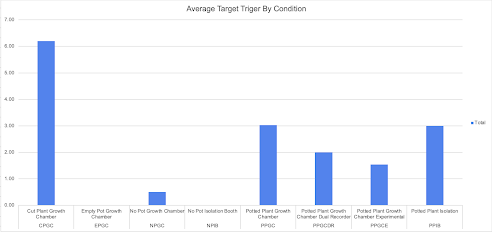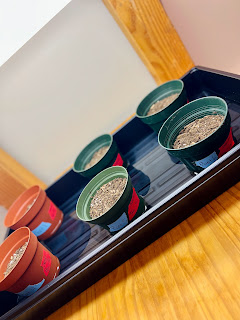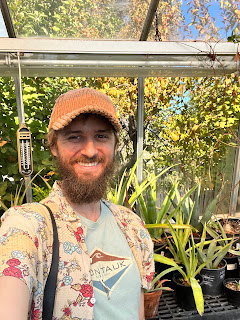Day Seventy-One
Fellow T.R.A.I.N. Scholars,
I decided this week to make my post about my project background. I was excited about this portion of information getting sculpted so that I may further use it for the final paper. There is so much self-discovery in research. You find yourself probing for a deeper understanding of something and perhaps understanding yourself more as you go. There is much connectivity all around us, and it is only natural to stop and look hard at a thing to grasp its function. The most curious of our species will forever be bound to asking questions. The subject matter can even take second place to the yearning of the search itself. Discovery is innate.
Alex S
*Attached is the first draft graphing of data. Further specification and detailing is needed.
*I still need to edit my thesis to make sure its worded correctly.
-------------------------------------------------------------------------------------------------------------------------------
Alex Shaw
T.R.A.I.N.
25 October 2022
Project Background
Research question: Can plants communicate with one another when in different states? If they are capable, is it dependent on voluntary or involuntary reactions? What states would plants need to communicate if this was possible? Would it be to warn one another, for example, or would there be other usefulness?
Hypothesis: Plants in stressed states are more likely to communicate with one another than those in non-stressed states.
What is currently known about the topic: The research thus far, although not conclusive, shows that plants may indeed be able to communicate with one another to warn each other of stressed conditions, including but not limited to drought tolerance and cutting. Hassanien, in a study in 2014, was able to deduce that sound waves can affect R.N.A. production and broadly promote division as well as the fluidity of cell walls (of callus cells) (Hassanien 2014). He draws associations between plant immunity and sound and increased resistance to pests.
Ueda, in 2012 set out to prove that "plants emit volatile organic compounds (V.O.C.s) as a means to warn other plants of impending danger" (Ueda 2012). These are encouraging results, and when considered, help humans see plants in a whole new light. The results “humanize” the plant if you will, and help enforce that its far from removed from our level of living. Another research scientist Ramesh and his team uncovered that plants use a similar chemical compound to communicate and warn one another while under threat of drought and extreme temperatures. Seeing multiple research scientists concluding that chemical reactions are taking place helps the hypothesis maintain its footing. Ueda's team also expands into the ranges of potential communication and touches on immunity to pests. Although there is not a plenitude of these studies, there is enough to say that a connection is being successfully drawn and that more research is needed. An observed objection is that all these studies are performed in laboratories, not in the natural world. The synthetic processes that lead scientists to the results must be considered. Running these experiments in the field could yield alternative results.
Plants seem to communicate in different ways; in some cases, the plant is sending electronic information to warn of its presence, which could deter a neighboring plant from rooting too close to it. In one study, once the plant and its soil were "touched," chemical signatures were put into the soil, warning one another that they had been in contact with an alien force; in this case, it would be the brush the researcher uses. Keeping in mind that these plants were not stressed in any way, it seemingly followed the same chemical reaction as if it had been. (Hess 2018).
Plants appear to have multiple motives to communicate with one another. In some cases, it is about stress; in others, it seems preemptive. For decades scientists have been aware of plants using chemicals. Still, until recently, there has not been abundant research diving into the how and whys of this enlightening form of communication. (Cox 2014). Cox dares to attribute this form of communication to a symbiotic relationship between a specific fungus and the plants, Mycorrhizal fungi. (Cox 2014). Cox educates the reader on the life cycle of this fungi, and its relation to the roots of different species of plants. The communication in this case, doesn’t seem to be the plant at all, but the fungi connecting root systems. This study focused on the plants being attacked by insects, as opposed to drought treatment or cutting.
The question remained, if plant communication is possible, what is the range of communication? "We recorded ∼65 dBSPL ultrasonic sounds 10 cm from tomato and tobacco plants, implying that these sounds could be detected by some organisms up to several meters away." (Khait 2019). If plants are within communicative boundaries of several meters, then it could be used as a chain effect; the plants on the edges of the meters mark could potentially recreate the signal and send it even farther out, creating no limit to how far plants can communicate. If they do, in fact, use root systems to carry these messages, then it is easy to see how complex these systems could be.
Khait's from the School of Plant Sciences and Food Security at Tel-Aviv Universitytargets an exchange of fluids inside the stem as it moves around, perhaps voluntarily in response to stress. Zweifel of the Swiss Federal Institute is confident that this process is cavitation. "Ultrasonic acoustic emission (U.A.E.) in trees is often related to collapsing water columns in the flow path as a result of tensions that are too strong (cavitation)." (Zweifel 2008). A tree using cavitation to communicate could be dangerous, since it involves water bubbles blocking the xylem.
Plants are known to communicate with one another; their forms and methods may vary depending on what study you dive into. Still, there is an apparent connection between levels of stress and the means to communicate. It appears that just like people, plants care about their community members and strive to protect their kind. Although this shows a undeniable association to animals of all kinds, further research is needed. Tests have varied, variables change, however it does appear that plants communicate; whether voluntarily or not.
Why it is important to expand on this current knowledge. The importance of this research extends much deeper than knowing whether plants talk to one another. It begins to help humans explain and see the complexity of things unavailable to them in totality. It reinforces that reactions are always happening outside the human scope and that the planet is teaming with all forms of interaction. Humans and plants share a complex relationship, having coevolved with one another. (Schaal 2018). To understand plants is to understand ourselves.
Five Additional Sources found for PB:
Cox, J. (2014). The aphids are coming! Jeff Cox tells how plants warn each other of pests. Horticulture Magazine. https://doi.org/https://go-gale-com.ezproxy.pc.maricopa.edu/ps/i.do?p=CSIC&u=mcc_phoe&id=GALE%7CA361352086&v=2.1&it=r&sid=summon
Hess, P. (2018). Unlike Humans, Plants Shown to be Sensitive to the Needs of Their Friends. Inverse. https://www.inverse.com/article/44433-how-do-plants-communicate-with-each-other
Ramesh, S., Tyerman, S., Xu, B. et al. GABA signaling modulates plant growth by directly regulating the activity of plant-specific anion transporters. Nature Communication 6, 7879 (2015). https://doi.org/10.1038/ncomms8879
Schaal, B. (2018). Plants and people: Our shared history and future. Plants People Planet. https://doi.org/10.1002/ppp3.12
Ueda, Hirokazu , et al. "Plant Signaling and Behavior." National Center for Biotechnology Information, 1 Feb. 2022, www.ncbi.nlm.nih.gov/pmc/articles/PMC3405699/.
Five Original Sources for Proposal
Hassanien, Reda He, and Tian-zhen Hou, et al. “Advances in Effects of Sound Waves on
Plants” Journal of Integrative Agriculture, vol. 13, no. 2, Feb. 2014, pp. 335-
348. Science Direct, https://doi.org/10.1016/S2095-3119(13)60492-X. Accessed Sep.
18th 2022
Jeong, Mi-Jeong, and Jung-II Cho, et al. "Sound frequencies induce drought tolerance in rice
plant" Pakistan Journal of Botony. 46(6): 2015-2020, 2014. ResearchGate
https://www.researchgate.net/publication/274890230_Sound_frequencies_induce_droug
ht_tolerance_in_rice_plant. Accessed Sep. 18th 2022
Khait, I., and O. Lewin-Epstein, et al. "Plants emit informative airborne sounds under stress."
DOI:https://doi.org/10.1101/507590
Prévost V, and David K, et al. "Diffusions of sound frequencies designed to target
dehydrins induce hydric stress tolerance in Pisum sativum seedlings" Heliyon, P.M.I.D.:
32995644; PMCID: PMC7511810. Sep. 2020, National Library of Medicine,
DOI:https://doi.org/10.1016/j.heliyon.2020.e04991. Accessed Sep. 18th 2022
Zweifel, R., and F. Zeugin. "Ultrasonic acoustic emissions in drought-stressed trees – more than
signals from cavitation?" New Phytologist, vol. 179, July 2008, pp. 1070-1090.
ResearchGate, DOI:10.1111/j.1469-8137.2008.02521.x. Accessed Sep. 18th 2022



Comments
Post a Comment